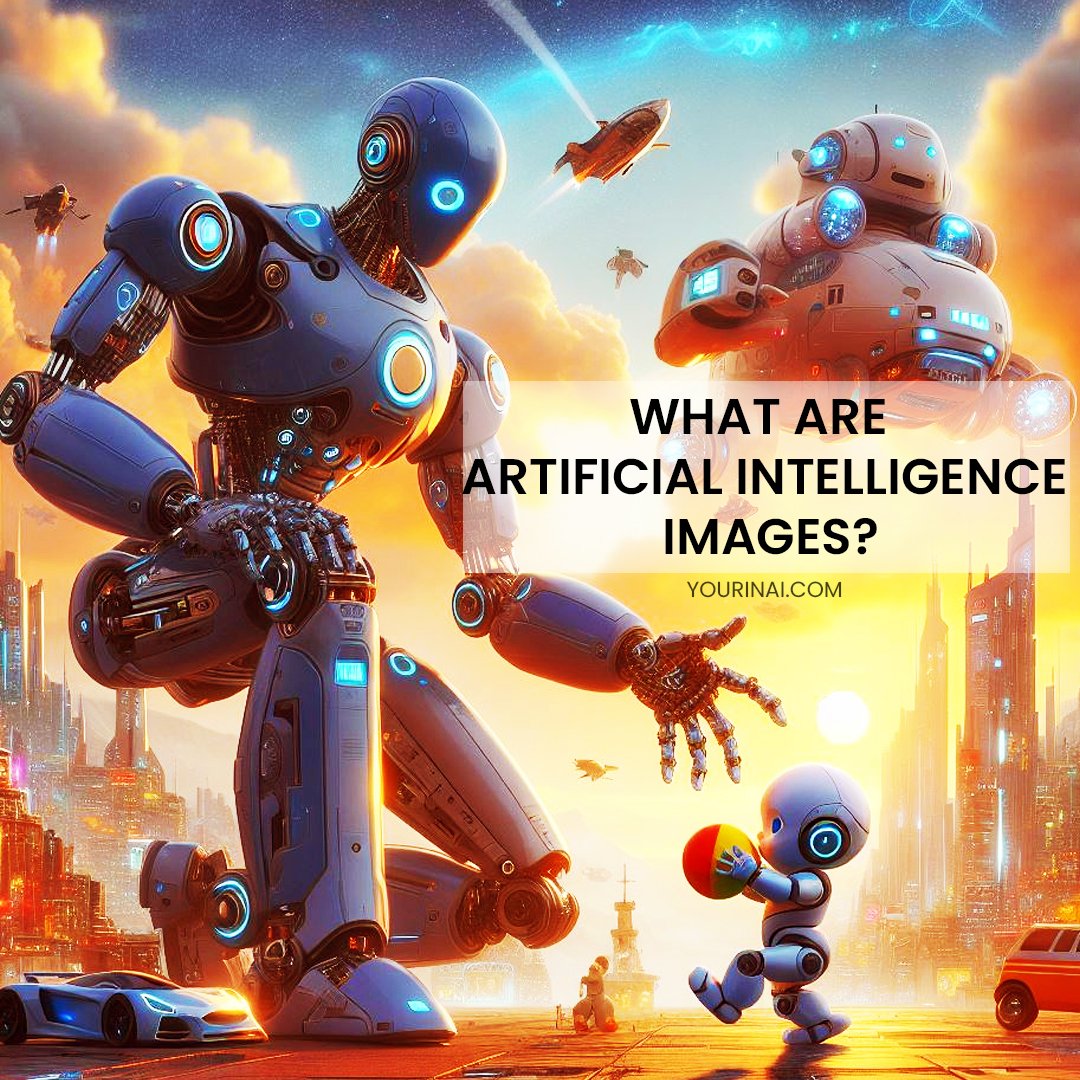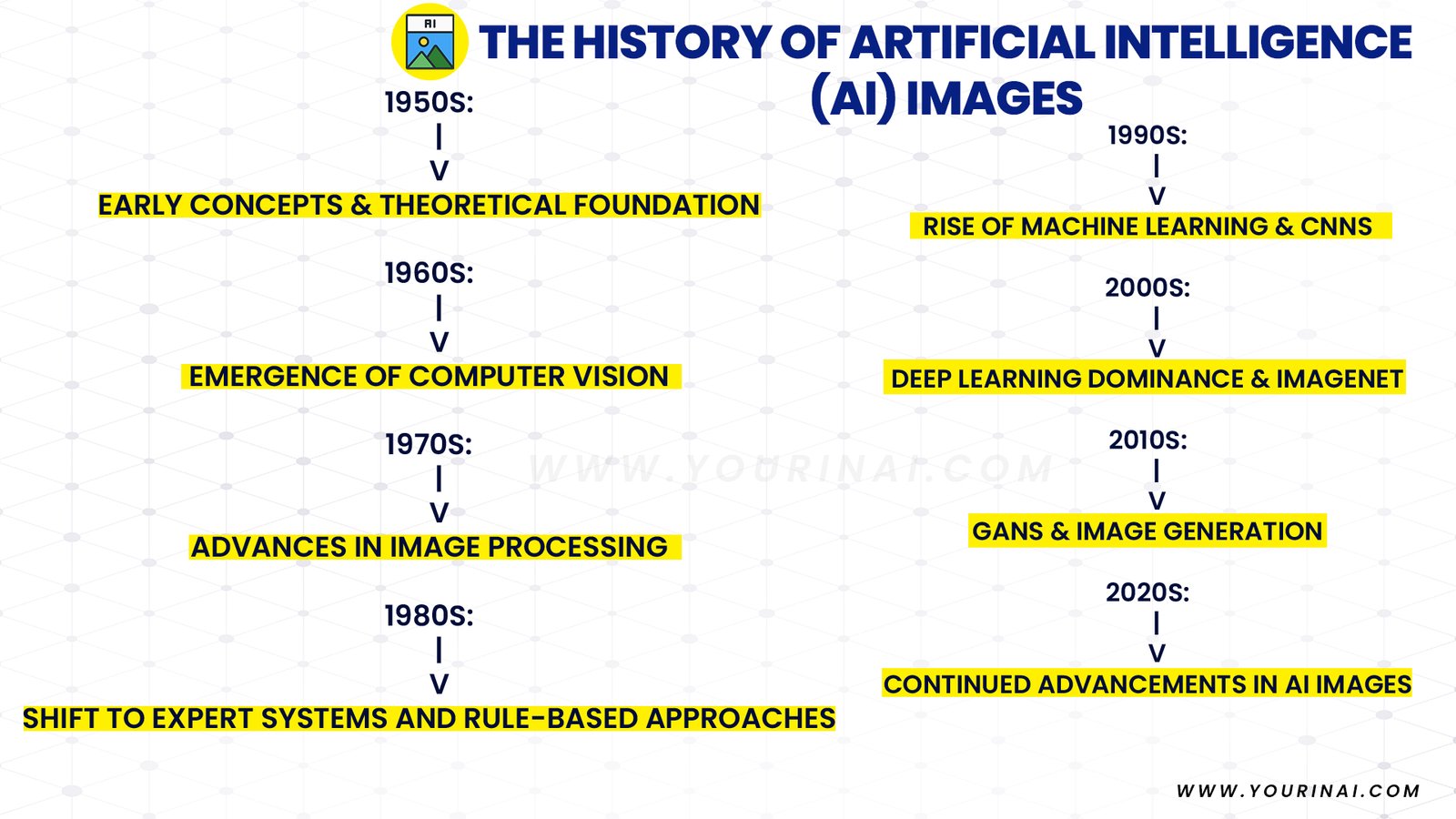Today, we will see how artificial intelligence (AI) has changed how we process and create images. Since its visionary roots in the 1950s, AI has revolutionized how we recognize and create images. Advances in deep learning, image recognition models, and GANs have opened up new opportunities for creativity and practical applications. AI-generated images’ history and current state reveal a dynamic field ripe for innovation. We covered all points about AI images.
What are artificial intelligence images?

How ai generates images? Let’s know if artificial intelligence images refer to images generated or processed using artificial intelligence (AI) techniques. AI can be applied to various image-related tasks, including image generation, image recognition, image enhancement, and more.
- AI-Generated Images: Images are created by artificial intelligence, often using techniques like Generative Adversarial Networks (GANs). These images can range from realistic faces to entirely imaginary scenes.
- AI-Based Image Recognition: AI algorithms process images for object recognition, classification, and detection. AI models are trained to understand and identify natural objects, people, or patterns within images.
- Image Enhancement with AI: Images are improved or modified using AI techniques like super-resolution or denoising. AI algorithms can enhance the high quality of images by adding details, reducing noise, or improving resolution.
- Artistic Style Transfer: AI algorithms can apply artistic styles to images, transforming them to resemble famous artworks or adopt specific visual characteristics.
- Medical Imaging with AI: In the medical field, AI analyzes medical images (X-rays, MRIs, CT scans). AI algorithms can assist in detecting anomalies, tumors, or other medical conditions.
- AI in Photography: AI is increasingly integrated into photography applications, helping with tasks like autofocus, image stabilization, and scene recognition to optimize camera settings.
- Content Creation: AI is used in creative applications, where it can assist in generating graphics, illustrations, or designs based on input parameters or user preferences.
“Artificial Intelligence images” generally refer to images that have been influenced, created, or processed using artificial intelligence techniques. The specific context will depend on the application and purpose of using AI for the images in question.
How AI generate images?
AI-generated images are created using a technique called Generative Adversarial Networks (GANs) or other similar generative models. GANs were introduced by Ian Goodfellow and his associates in 2014. Here’s a simplified explanation of how AI images are created using GANs:
- Generator Network: The process starts with a generator neural network. This network takes random noise as input and generates images. Initially, these generated images are arbitrary and meaningless.
- Discriminator Network: Simultaneously, there is a discriminator neural network. This network’s job is to distinguish between authentic images and the fake images generated by the generator.
- Training Process: The generator and discriminator are prepared simultaneously competitively. The generator tries to make images increasingly Hard for the discriminator to distinguish from real images. In contrast, the discriminator aims to improve its ability to differentiate between authentic and generated images.
- Adversarial Training: The training process involves a back-and-forth competition. The generator gets good at creating realistic images as it learns from its mistakes (feedback from the discriminator), and the discriminator improves at distinguishing between authentic and generated images.
- Convergence: Ideally, this process continues until the generator creates indistinguishable images from real ones, and the discriminator can’t reliably tell the difference.
- Image Generation: Once the GAN is trained, generating images feeds random noise into the trained generator network. The generator then transforms this noise into images that, ideally, closely resemble the training data.
GANs have been widely used for various creative applications, including generating realistic human faces, artwork, and more. It’s important to note that the quality of images depends on the complexity of the GAN model, the amount and quality of training data, and the training process. The generative models, such as Variational Autoencoders (VAEs), can also be used for image generation, each with its approach and characteristics.
History of artificial intelligence images

Here is a more detailed information about the diagram ⏬
- 1950s: Early Concepts & Theoretical Foundation
- The 1950s marked the inception of AI, with pioneers like Alan Turing laying the theoretical groundwork for intelligent machines. Early AI systems focused on symbolic reasoning and logic rather than visual perception.
- 1960s: Emergence of Computer Vision
- Computer vision, a subfield of AI dedicated to interpreting visual information, began to emerge. Early attempts at image processing, including techniques like edge detection, set the stage for AI’s interaction with visual data.
- 1970s: Advances in Image Processing
- The 1970s saw increased research in image processing, with the development of algorithms for tasks like pattern recognition and feature extraction. The era witnessed progress in machine vision and image understanding.
- The 1980s: Shift to Expert Systems and Rule-Based Approaches
- AI research shifted focus to expert systems and rule-based approaches, with less emphasis on image-related tasks. Image analysis and computer vision continued to progress, relying on symbolic representations.
- 1990s: Rise of Machine Learning & CNNs
- The 1990s witnessed the rise of machine learning techniques, including neural networks. Convolutional Neural Networks (CNNs) started to be applied to image recognition tasks. The creation of the ImageNet database in 2009 played a crucial role in advancing image recognition through large-scale deep learning.
- 2000s: Deep Learning Dominance & ImageNet
- Deep learning techniques and intense neural networks became the dominant paradigm in image processing and computer vision. Breakthroughs in image classification, object detection, and segmentation were achieved using deep learning models fueled partly by the ImageNet database.
- 2010s: GANs & Image Generation
- The 2010s saw the rise of Generative Adversarial Networks (GANs), enabling the generation of realistic images. Deep learning models, such as CNNs, achieved unprecedented accuracy in image classification tasks.
- 2020s: Continued Advancements in AI Images
- Ongoing research in the 2020s continues to push the boundaries of AI in image-related tasks. Innovations in areas like image captioning, style transfer, and image synthesis contribute to the evolving landscape of AI-generated images. The timeline reflects a trajectory of progress in AI image technologies, with an ongoing quest for improved capabilities and applications.
What is generative AI?
Generative AI, deep learning or machine learning, is an artificial intelligence capable of generating new and meaningful data. One popular approach is Generative Adversarial Networks (GANs), where a generator produces content (like images), and a discriminator evaluates its realism. Generative AI can be used for creative tasks, such as generating art, music, or realistic faces, and it’s versatile across various applications. It’s about machines learning to create new, valuable content rather than just analyzing existing data.
How are AI image generators trained?
- Data Collection: Gather a large dataset representing the images you want the AI to generate. The dataset should be diverse and cover various aspects of the desired content.
- Architecture Selection: Choose a suitable generative model architecture, like Generative Adversarial Networks (GANs), Variational Autoencoders (VAEs), or other relevant models based on your requirements.
- Network Design: Design the architecture of the generator neural network. This network will take random input (noise) and generate images. For GANs, there is also a discriminator network that evaluates the generated images.
- Training Process: The generator produces images during training, and the discriminator evaluates them. The generator learns to improve its outputs based on feedback from the discriminator. This back-and-forth training continues until the generator creates realistic images.
- Optimization: Adjust the model’s parameters and hyperparameters to optimize its performance. This involves fine-tuning to enhance the quality and diversity of generated images.
- Validation: Validate the Trian model on a different dataset to ensure it generalizes well and produces high-quality images beyond the training set.
How are AI-generated images created?
- Input Random Noise: Provide the trained generator with random noise as input. This noise serves as the starting point for creating a new image.
- Generate Image: The generator transforms the random noise into an image based on what it learned during training. The output can be entirely new and may resemble patterns from the training data.
- Adjust Output (Optional): Depending on the application, you may have options to adjust parameters or guide the generator’s output to meet specific criteria or styles.
- Output the Generated Image: The generator produces the final AI-generated image, which can be used for various purposes like art, design, or any creative application.
What free AI can generate images?
The free AI tools and platforms allow users to generate images. Please note that availability of such tools may change over time, and new tools may emerge. Here are a few examples:
- Deep Dream Generator: This online tool uses a neural network to enhance and modify images in a dream-like manner. It’s based on the Inception model and was developed by Google.
- RunwayML: RunwayML provides a variety of pre-trained models for creative purposes, including image generation, style transfer, and more. It has both free and paid models.
- Artbreeder: Artbreeder allows users to blend and manipulate images to create new and unique visuals. While a free version exists, premium features are available through a subscription.
Conclusion – How AI generates images
The history of AI in images has come a long way, starting with theoretical foundations in the 1950s and evolving to recent breakthroughs like Generative Adversarial Networks (GANs). GANs enable machines to analyze, analyze, and generate images, with a training process involving data collection, model selection, and optimization.
The focus has shifted from symbolic reasoning to deep learning, notably in image recognition, with models like Convolutional Neural Networks (CNNs) and datasets like ImageNet playing key roles. Free AI tools like Deep Dream Generator and RunwayML make AI-generated images accessible for creative exploration.
The collaboration between human creativity and AI promises ongoing innovation in generating diverse and high-quality images. AI images’ history and current state showcase a dynamic field with potential exciting developments.
FAQ: Artificial Intelligence Images
- What are artificial intelligence images?
- Artificial intelligence images refer to images generated, processed, or influenced by artificial intelligence (AI) techniques. This includes AI-generated images, image recognition, enhancement, style transfer, and various applications where AI interacts with visual data.
- How does AI generate images?
- AI generates images using Generative Adversarial Networks (GANs) or other generative models. GANs consist of a generator network that creates images from random noise and a discriminator network that evaluates their authenticity. Through adversarial training, the generator learns to create realistic images.
- What is the history of artificial intelligence images?
- The history of AI images spans from the theoretical foundations in the 1950s to the dominance of deep learning in the 2010s. Key milestones include the emergence of computer vision, advances in image processing, the rise of machine learning and CNNs, and the development of Generative Adversarial Networks (GANs).
- What is generative AI?
- Generative AI refers to artificial intelligence capable of generating new and meaningful data. It involves creating content, such as images, using models like GANs. Generative AI is applied in creative tasks like art generation, music composition, and realistic face synthesis.
- How are AI image generators trained?
- AI image generators are trained by collecting a diverse dataset, selecting a generative model architecture, designing the network, and engaging in a training process where the generator refines its output based on feedback from a discriminator. The model is optimized, validated, and ready to generate images.